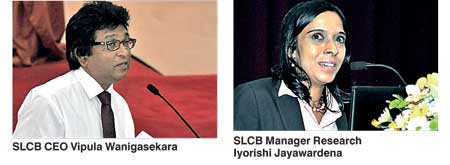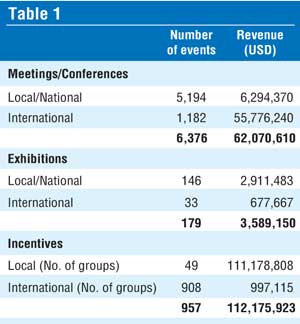Monday Dec 15, 2025
Monday Dec 15, 2025
Wednesday, 22 July 2015 00:00 - - {{hitsCtrl.values.hits}}
By Himal Kotelawala
The MICE (Meetings, Incentives, Conferences and Exhibitions) industry in the Sri Lanka tourism sector became a $ 177 million worth industry in the year 2013 with  94% of the total revenue being generated by international MICE events, according to findings published by the Sri Lanka Convention Bureau (SLCB). This was a $ 17 million over the previously estimated figure, a freshly compiled MICE Tourism Research Bulletin has confirmed. Following the end of the separatist conflict in 2009, the bulletin reveals, the industry has shown remarkable growth.
94% of the total revenue being generated by international MICE events, according to findings published by the Sri Lanka Convention Bureau (SLCB). This was a $ 17 million over the previously estimated figure, a freshly compiled MICE Tourism Research Bulletin has confirmed. Following the end of the separatist conflict in 2009, the bulletin reveals, the industry has shown remarkable growth.
Officially made available to industry members yesterday at a special presentation made by SLCB CEO Vipula Wanigasekara and Manager Research Iyorishi Jayawardena at the Sri Lanka Institute of Tourism and Hotel Management auditorium in response to the high volume of information requests made seeking MICE tourism data, the bulletin reports that roughly 63% of the total revenue for 2013 had come through the incentives segment. The total MICE arriv als including incentive travel that year, the bulletin further reports, had reached 134,488, approximately 13.5% of the total number of MICE participants attending national/local and international events – an increase of over 1,000 from the initial estimate.
als including incentive travel that year, the bulletin further reports, had reached 134,488, approximately 13.5% of the total number of MICE participants attending national/local and international events – an increase of over 1,000 from the initial estimate.
Even though the percentage of revenue generated by international events was unprecedentedly high, only 2,123 international events had been held in the year 2013 – just 28% of the total number of MICE events. The bulletin attributes this fact to foreign exchange earnings. Meanwhile, the total number of national/local MICE events held is 5,389 with 859,031 local participants. Revenue generated from the local events amounts to little over $ 10 million.
Table 1 shows a breakdown of meetings/conferences, incentives and exhibitions for the year 2013
The findings have also revealed that there has been an increase in the number of smaller meetings, a relatively higher preference for in-house meetings and conferences at hotels over traditional convention venues and growth in the incentives segment, in line with current global trends (table 2).
It is noteworthy that over the past decade, according to SLCB’s findings, DMCs, PCOs and event management companies together with convention venues such as the BMICH and the SLECC have played a more active role in the Sri Lankan MICE business. The international meetings segment had given city hotels a considerable volume of business in 2013 from the international meetings segment (23.4%) and international incentive groups (12.4%), while resort hotels managed to secure 93.8% of local incentives and 69% of international groups, as well as smaller local meetings and conferences (80.8%), the real strength of resorts in the MICE industry.

The SLCB has also found that the BMICH and PICO – SLECC have continued to be the go-to venue for exhibitions, into 2013, with rapid growth in the number of annually held local exhibitions. As an interesting aside, the country’s biggest convention centre is located at Temple Trees, with a seating capacity of 7,000.
Unlike revenue generated by other elements of MICE where international meetings and incentives bring in a higher income, notes the SLCB, a relatively high proportion of revenue generated by this segment was from local exhibitions, mainly due to the fact that there had been only a handful of international exhibitions held in Sri Lanka. “The country still lags behind in infrastructure to hold larger international exhibitions,” states the report.
Determining exact outcomes of MICE tourism is a challenging task since MICE information needs to be obtained from the industry, unlike leisure tourism arrival figures which are available in the immigration arrival cards. Globally, there is very limited research focusing on MICE tourism and we embarked on this study in 2014 with many hurdles; a situation made further complicated by the fact that most hoteliers are reluctant to divulge numbers, in an increasingly competitive business.
According to the SLCG, the statistics presented in the bulletin are based on both primary and secondary data as well as the expertise of SLCB gained through a three-decade long relationship with the MICE industry as the government institution mandated to promote Sri Lanka as a venue for MICE.
“This is yet another step taken by SLCB towards supporting the MICE business stakeholders. Being the first MICE research study to be conducted after several years in the Sri Lankan post-war era, it is a significant project and one that would be the benchmark for future research,” said Jayawardena.
Pix by Lasantha Kumara